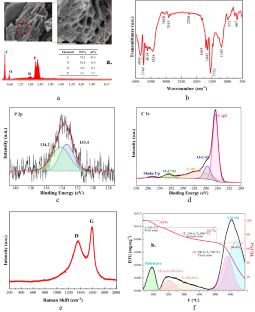Adsorption ( IF 3.3 ) Pub Date : 2024-04-14 , DOI: 10.1007/s10450-024-00461-y John J. Alvear-Daza , Julián A. Rengifo-Herrera , Luis René Pizzio

|
In this study, activated carbon (AC) obtained from biomass waste materials (sunflower seed shells -SSS) was synthesized by combining chemical (H3PO4 80% wt.) and thermal activation (at 544 °C). Synthesized AC exhibited a BET surface area of 1531 m2 g−1, and pore volume of 0.98 cm3 g−1. The material exhibited various surface functional groups, such as P2O7, C-O-P and -COOH, O = C, as well as a moderate graphitization degree (ID/IG < 1) and acidity caused by H3PO4 treatment. Moreover, its morphology and physicochemical features were evaluated by SEM–EDS, TGA, XPS, Raman, and FT-IR techniques. The material was used to study the adsorption of anti-inflammatory pharmaceutical compounds such as ibuprofen (IBF) and diclofenac (DIF) present in natural groundwater samples. The effects of parameters such as pH, activated carbon dose, temperature, and IBF or DIF initial concentration were optimized by using a central composite design (CCD). The results revealed that optimum conditions to remove DIF and IBF from natural groundwater samples were pH of 8.0 and 7.0, an AC dose of 0.79 and 1.0 g L−1, and a contact time of 60 min for DIF and IBF, respectively. A successful procedure to desorb both pollutants from adsorbent by using acetonitrile solutions was achieved, allowing the reuse study whose main results were that after four reusing cycles AC reduced its efficiency to remove DIF and IBF in 28 and 34%, respectively. Finally, the effect of ions, such as nitrate, bicarbonate, and sulfate at concentrations commonly found in natural groundwater on the adsorption of both pollutants onto AC was studied using deionized water. As a result, this study suggests considerable interest of AC in real applications due to its versatility and prolonged reuse to effectively remove anti-inflammatory compounds from natural aqueous solution.
Graphical Abstract
中文翻译:

天然地下水样品中葵花籽壳(向日葵)合成活性炭吸附双氯芬酸和布洛芬的性能和优化
在本研究中,通过结合化学(H 3 PO 4 80% wt.)和热活化(544 °C)合成从生物质废料(葵花籽壳-SSS)中获得的活性炭(AC) 。合成的AC表现出1531 m 2 g -1的BET表面积和0.98 cm 3 g -1的孔体积。该材料表现出多种表面官能团,如P 2 O 7、COP和-COOH、O = C,以及适度的石墨化程度(ID / IG < 1)和由H 3 PO 4处理 引起的酸性。此外,通过SEM-EDS、TGA、XPS、拉曼和FT-IR技术评估了其形貌和理化特征。该材料用于研究天然地下水样品中存在的布洛芬 (IBF) 和双氯芬酸 (DIF) 等抗炎药物化合物的吸附。通过使用中心复合设计 (CCD) 优化 pH、活性炭剂量、温度和 IBF 或 DIF 初始浓度等参数的影响。结果表明,从天然地下水样品中去除DIF和IBF的最佳条件分别为pH值8.0和7.0、AC剂量分别为0.79和1.0 g L -1以及DIF和IBF的接触时间为60 min。使用乙腈溶液成功地从吸附剂中解吸这两种污染物,从而进行了再利用研究,其主要结果是,在四次再利用循环后,AC 去除 DIF 和 IBF 的效率分别降低了 28% 和 34%。最后,使用去离子水研究了天然地下水中常见浓度的离子(例如硝酸根、碳酸氢根和硫酸根)对活性炭吸附这两种污染物的影响。因此,这项研究表明活性炭因其多功能性和长期重复使用以有效去除天然水溶液中的抗炎化合物而在实际应用中引起了极大的兴趣。



























 京公网安备 11010802027423号
京公网安备 11010802027423号